Core training has been described by Mike Boyle as: "The ability to create extremity movement without compensatory movement of the spine or pelvis." This definition makes Pilates an exceptional method of core training. The next couple of posts I hope to highlight some variations of basic core training exercises including the bridge, planks, and chest lift which are all part of the Pilates repertoire of core conditioning.
In a previous post, I discussed the importance of training the gluteus maximus. Lack of gluteal activation is implicated in low back pain as well as hamstring tightness and injury. The gluteus maximus is the prime mover in hip extension necessary for running and jumping, hip abduction for lateral stepping, and hip external rotation necessary for swinging and throwing. These motions are obviously important in all athletics however we sometimes opt to avoid training the glutes and assume that running will be enough to strengthen them.
Due to inactivity and prolonged sitting hip flexors become tight and glutes are shut down. Glutes don't like to get activated from basic motions like standing up from a chair or walking. They tend to lay low unless we suddenly have to break out in a sprint, leap in the air, or pick something heavy up off the ground. For most of us, these situations rarely occur. Hamstrings and sometimes the low back jump in to assist in motions that gluteals should dominate. Hamstring strains relate strongly to poor glute activation. Being hamstring and low back dominant rather than glute dominant, creates an inappropriate sequence of muscle firing patterns which can result in pain and strain.
A great exercise, available in many variations and progressions is the supine glute bridge. Noted physiologist Gray Cook, devised a beginner bridge to help activate appropriate gluteal neural connections. The Cook Bridge involves hugging one knee to the chest and then lifting the hips and pelvis, perhaps just a few inches. By hugging the knee in toward the chest we limit lumbar extension and demand that the gluteus initiate hip extension rather than the low back. The Cook lift keeps the lumbar spine in neutral (a hallmark of core training) and isolates the glutes. Hold this position 10-15 seconds maintaining constant attention to gluteal activation. This may also be performed for 10-15 reps on each leg.
In a previous post, I discussed the importance of training the gluteus maximus. Lack of gluteal activation is implicated in low back pain as well as hamstring tightness and injury. The gluteus maximus is the prime mover in hip extension necessary for running and jumping, hip abduction for lateral stepping, and hip external rotation necessary for swinging and throwing. These motions are obviously important in all athletics however we sometimes opt to avoid training the glutes and assume that running will be enough to strengthen them.
Due to inactivity and prolonged sitting hip flexors become tight and glutes are shut down. Glutes don't like to get activated from basic motions like standing up from a chair or walking. They tend to lay low unless we suddenly have to break out in a sprint, leap in the air, or pick something heavy up off the ground. For most of us, these situations rarely occur. Hamstrings and sometimes the low back jump in to assist in motions that gluteals should dominate. Hamstring strains relate strongly to poor glute activation. Being hamstring and low back dominant rather than glute dominant, creates an inappropriate sequence of muscle firing patterns which can result in pain and strain.
A great exercise, available in many variations and progressions is the supine glute bridge. Noted physiologist Gray Cook, devised a beginner bridge to help activate appropriate gluteal neural connections. The Cook Bridge involves hugging one knee to the chest and then lifting the hips and pelvis, perhaps just a few inches. By hugging the knee in toward the chest we limit lumbar extension and demand that the gluteus initiate hip extension rather than the low back. The Cook lift keeps the lumbar spine in neutral (a hallmark of core training) and isolates the glutes. Hold this position 10-15 seconds maintaining constant attention to gluteal activation. This may also be performed for 10-15 reps on each leg.
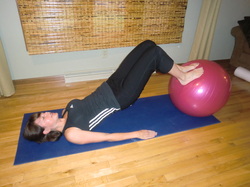
This picture demonstrates another variation of the basic supine glute bridge by adding the exercise ball. The goal again is to keep the spine stable and in neutral while "awakening" the dormant glutes. Simply maintaining the lift for 10-15 seconds or lowering and lifting for 10-15 reps will challenge the glutes.
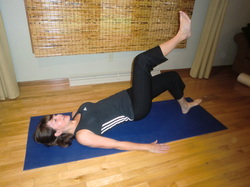
As we master basic versions of the bridge we can move to more challenging progressions like single leg glute bridges and "marching" both on the mat as well as the ball or foam roller.
If you feel overactive through the hamstrings while performing your bridge, slide the working leg further away from your body thus decreasing knee flexion. Be careful to avoid arching through the low-back.
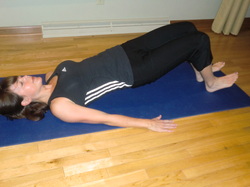
Lifting your toes works to decrease use of the quadriceps and helps to activate the glutes.
Basic movements like glute bridges help to re-educate neural connections. Over time, with increased reps, variations, and weights this exercise moves from being an activation exercise to a power and strength training exercise. Your glutes want to demonstrate their power...they're just waiting for the chance!
Basic movements like glute bridges help to re-educate neural connections. Over time, with increased reps, variations, and weights this exercise moves from being an activation exercise to a power and strength training exercise. Your glutes want to demonstrate their power...they're just waiting for the chance!
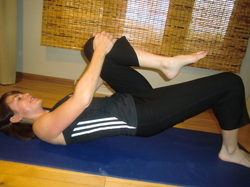
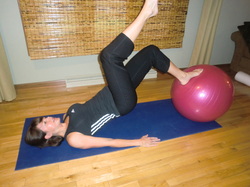
 RSS Feed
RSS Feed